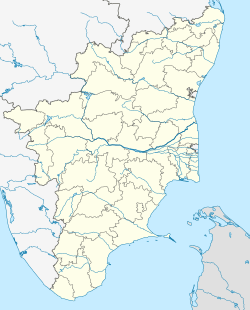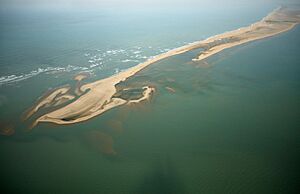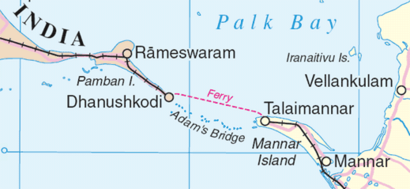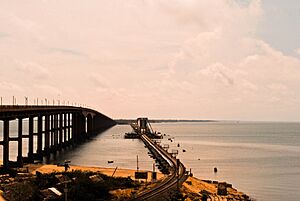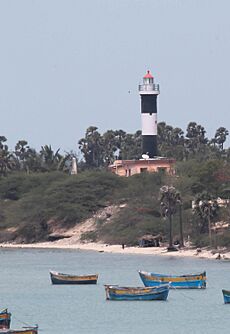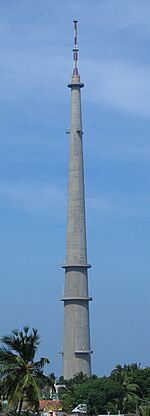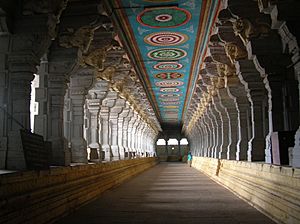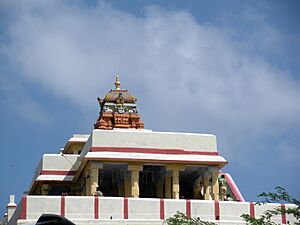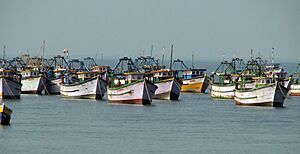Rameswaram facts for kids
Quick facts for kids
Rameswaram
|
|
|---|---|
|
Town
|
|

From top: Ramanathaswamy Temple tower, Pamban Bridge, and a set of fishing boats.
|
|
| Nickname(s):
Rameswaram, Ramesvaram, Rameshwaram, ராமேஸ்வரம்
|
|
| Country | |
| State | Tamil Nadu |
| District | Ramanathapuram |
| Government | |
| • Type | Second Grade Municipality |
| • Body | Municipality of Rameswaram |
| Area | |
| • Total | 55 km2 (21 sq mi) |
| Elevation | 10 m (30 ft) |
| Population
(2011)
|
|
| • Total | 44,856 |
| • Density | 816/km2 (2,112/sq mi) |
| Demonym(s) | Rameswaram mar |
| Language | |
| • Official | Tamil |
| Time zone | UTC+5:30 (IST) |
| PIN CODE |
623526
|
| Vehicle registration | TN 65 |
Rameswaram is a town in the Tamil Nadu state of India. It is located on Pamban Island, which is separated from mainland India by a narrow channel. The island is connected to the mainland by the famous Pamban Bridge. Rameswaram is about 40 kilometers (25 miles) from Mannar Island in Sri Lanka.
This town is considered one of the holiest places in India for Hindus. It is a part of the Char Dham pilgrimage, a journey to four sacred sites. According to the ancient Hindu epic Ramayana, the god Rama built a bridge from here to Lanka (modern-day Sri Lanka). He did this to rescue his wife Sita from the demon-king Ravana.
The main temple in Rameswaram is dedicated to the Hindu god Shiva. It is closely linked to the stories of Rama and Shiva. Both the temple and the town are important pilgrimage sites for followers of Shiva (Shaivas) and Vishnu (Vaishnavas). Rameswaram is also a major center for fishing and tourism.
Contents
Stories and Legends
The name Rameswaram means "Lord of Rama" in Sanskrit. This refers to Shiva, who is the main god worshipped at the Ramanathaswamy Temple.
According to the Hindu epic Ramayana, Rama (an avatar of the god Vishnu) prayed to Shiva here. He wanted to ask for forgiveness for any sins he might have committed during his war against Ravana.
The story says that Rama, his wife Sita, and his brother Lakshmana set up a lingam (a symbol of Shiva) here. This was to cleanse the sin of killing Ravana, who was a Brahmin. Rama wanted a lingam from the Himalayas for this worship. He asked his loyal helper Hanuman to bring it.
Since Hanuman took a long time, Sita made a lingam out of sand from the nearby seashore. This sand lingam is believed to be the one in the temple's main shrine today. There is also a place called Sethu Karai, about 22 kilometers (14 miles) from Rameswaram. People believe Rama started building his floating stone bridge, the Ramsetu bridge, from here.
A Look at History
Rameswaram's history is mostly about its role as a stopping point to reach Sri Lanka. It is also famous for the Ramanathaswamy Temple. Ancient Tamil poems from the 7th and 8th centuries mention Shiva and the temple.
The Jaffna kingdom (1215–1624 CE) in Sri Lanka had strong ties to Rameswaram. Its kings were called Setukavalan, meaning "custodians of Rameswaram." They were Hindus and gave a lot of money to the temple.
In the early 14th century, a general named Malik Kafur from the Delhi Sultanate reached Rameswaram. He built a mosque there. Later, in the 15th century, the area was ruled by the Pandya dynasty.
The town then came under the Vijayanagara Empire in 1520 CE. The Sethupathis, who broke away from the Madurai Nayaks, ruled Ramanathapuram. They made big contributions to the Ramanathaswamy temple, making it an amazing architectural site.
By 1795 CE, Rameswaram came under the control of the British East India Company. After India gained independence in 1947, the town became part of modern India.
Geography and Nature
Rameswaram is an island shaped like a conch shell. It covers an area of about 61.8 square kilometers (23.9 square miles). Most of the land is sandy because it's surrounded by the sea. The Palk Strait is to the northwest, and the Gulf of Mannar is to the southeast.
The Ramanathaswamy Temple takes up a large part of the town. The beach in Rameswaram is very calm, with waves usually rising only a few centimeters. It looks more like a very large river than a sea.
Rameswaram has a dry tropical climate. It gets most of its rain from the North-East monsoon between October and January.
The Ramsetu Bridge is a chain of limestone sandbanks between Rameswaram and Mannar Island in Sri Lanka. Scientists believe this bridge was once a land connection between India and Sri Lanka. It is about 30 kilometers (18 miles) long.
Historical records suggest that the bridge was walkable until the 15th century. A cyclone in 1480 CE is said to have broken it. The ancient Indian epic Ramayana describes Rama's army of ape-men building this bridge to reach Lanka. This is why it's also called Rama Setu or "Rama's Bridge."
People and Population
Rameswaram had a population of 44,856 people in 2011. For every 1,000 males, there were 969 females. Most people in Rameswaram are Hindus (87.4%). There are also communities of Christians (8.13%) and Muslims (4.36%). The town's average literacy rate was 73.36%, which is close to the national average.
Economy and Jobs
Since Rameswaram is a pilgrimage town, most people work in jobs related to tourism. This includes trade and services. Fishing used to be a main job for people on the island. However, many have moved to other jobs because fishing doesn't always bring in enough money.
Rameswaram has good road connections to cities like Madurai and Trichy. The government is working to improve these roads as more tourists visit each year.
Getting Around and Staying Connected
The Pamban Bridge is a very important structure. It's a cantilever bridge that connects Rameswaram to mainland India. The railway part of the bridge is 2,065 meters (6,776 feet) long and opened in 1914. It has a special section that can be raised to let ships pass underneath.
Historically, the bridge was opened by hand using levers. About 10 ships pass through it every month. After the bridge was built, train lines connected Rameswaram and Dhanushkodi to the mainland. A famous train called the Boat Mail used to run on this track. However, the line to Dhanushkodi was destroyed in a cyclone in 1964.
Today, there are daily express trains connecting Rameswaram to major cities in Tamil Nadu. The main road link is the National Highway from Ramanathapuram. Before the train service in 1914, boats were the only way to reach Rameswaram island.
The Rameswaram municipality manages a total road length of 52 kilometers (32 miles). The Tamil Nadu State Transport Corporation runs daily bus services to Rameswaram.
Rameswaram is home to the tallest TV tower in India. It is 323 meters (1,060 feet) tall. There are also two lighthouses in Rameswaram: the Pamban lighthouse and the Rameswaram lighthouse.
Education and Services
Rameswaram has a lower literacy rate compared to the state average. There are two government high schools, one for boys and one for girls. Several other schools, including private and religious schools, are also present. Alagappa University Evening College is the only college in town. Other colleges are in nearby cities.
The town gets its electricity from the Tamil Nadu Electricity Board. Water is supplied by the Rameswaram Municipality from various sources. The town collects about 6 metric tons of waste every day.
For communication, Rameswaram is part of the Karaikudi Telecom circle. Bharat Sanchar Nigam Limited (BSNL) provides phone and internet services, along with other companies.
Things to See and Do
Rameswaram is a very popular Hindu pilgrimage center. Thousands of devotees visit every day to see the temple's image of the deity Shiva.
Ramanathaswamy Temple
The Ramanathaswamy Temple is the most famous historical building in Rameswaram. It is a Hindu temple dedicated to the god Shiva. This temple is one of the 12 Jyotirlinga shrines, where Shiva is worshipped as a "pillar of light." It is also one of the 275 Paadal Petra Sthalam temples, praised in hymns by ancient saints.
The temple as it looks today was built in the 12th century by the Pandya Dynasty. It has the longest corridor of any Hindu temple in India. The corridor is about 5 to 6.4 meters (17 to 21 feet) wide and 7.6 meters (25 feet) high. Each pillar is carved in the Nayak style. Kings from the Sethupathy dynasty (17th century) also added a lot to the temple. Even rulers from Sri Lanka helped build parts of it.
Holy Water Bodies
There are 64 Tīrthas or holy water bodies in and around Rameswaram. Twenty-four of these are very important. Fourteen of them are tanks and wells inside the temple grounds. Taking a bath in these tanks is a big part of the pilgrimage to Rameswaram.
The most important one is called Agni Tirtham, which is the sea (Bay of Bengal). Another important place is Jatayu Tirtham. It is believed that Jatayu, a demigod in the form of a vulture, fell here after fighting Ravana to save Sita. Villoondi Tirtham, meaning "buried bow," is about 7 kilometers (4.3 miles) from the main temple. People believe Rama dipped his bow into the sea here to get fresh water for Sita.
Gandhamathana Parvatham
Gandhamathan Parvatham is a small hill about 3 kilometers (1.9 miles) north of the temple. It is the highest point on the island. In a two-story hall, people worship Rama's feet, which are believed to be imprinted on a wheel.
Dhanushkodi
Dhanushkodi is the southernmost tip of the island. It has the Kothandaramaswamy Temple, dedicated to Rama. Even though Dhanushkodi was destroyed by a cyclone in 1964, the temple remained standing. It is about 18 kilometers (11 miles) from the town center. Local stories say that Dhanushkodi is where Vibishana, Ravana's brother, surrendered to Rama.
Hindu Pilgrimage

Rameswaram is very important for many Hindus. A pilgrimage to Varanasi is often considered incomplete without also visiting Rameswaram. The town and the Ramanathaswamy temple are one of the four holiest Hindu Char Dham sites. The other three are Badrinath, Puri, and Dwarka.
These four sites are located in the four corners of India. Hindus believe it is sacred to visit these temples at least once in their lifetime. Traditionally, the journey starts from Puri in the east and goes clockwise.
Rameswaram and Sri Lanka
Rameswaram is often in the news because of issues with fishermen. Indian fishermen sometimes face problems with the Sri Lankan navy. This is due to fishing activities near the border.
Fishery in Rameswaram
Since Rameswaram is an island, many people traditionally work in fishing. There is a yearly 45-day ban on fishing with motorboats in the area. The jetty in Rameswaram is the largest place for fishing boats to land in the region. It becomes very busy after the ban ends.
The Sea World Aquarium is near the Rameswaram Bus Stand. It has many different underwater creatures, including exotic species. It is the only one of its kind in the state.
Kachchatheevu Island
There has been some disagreement between India and Sri Lanka over Kachchatheevu. This is an uninhabited island about 15 kilometers (9.3 miles) north of Rameswaram. It belongs to Sri Lanka. An agreement from 1974 allows fishermen from both countries to rest and dry their nets on the island. However, Indian fishermen have reported attacks by the Sri Lankan navy.
A yearly two-day festival for Saint Anthony on the island attracts many fishermen from both countries. This event also used to be a place for Indian and Sri Lankan fishermen to meet and discuss their problems.
Sethusamudram Canal Project
The Sethusamudram Shipping Canal Project aims to connect the Palk Bay and the Gulf of Mannar. This would create a shipping canal through the shallow sea, sometimes called Ram Setu or Rama's Bridge. Some groups are against digging through Rama Setu. They say it's important for religious, environmental, and economic reasons. They want the project to use a different route that doesn't harm the structure. The project has been stopped since 2010 by a court order.
Famous People
- A. P. J. Abdul Kalam (1931–2015) – He was the former President of India from 2002 to 2007. He was also a scientist and advisor.
See also
 In Spanish: Rameswaram para niños
In Spanish: Rameswaram para niños


